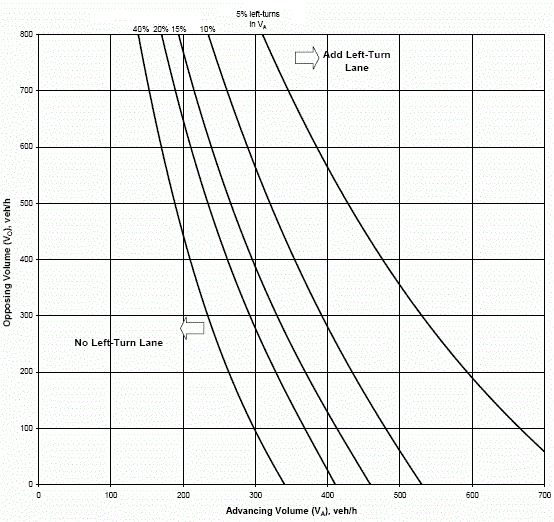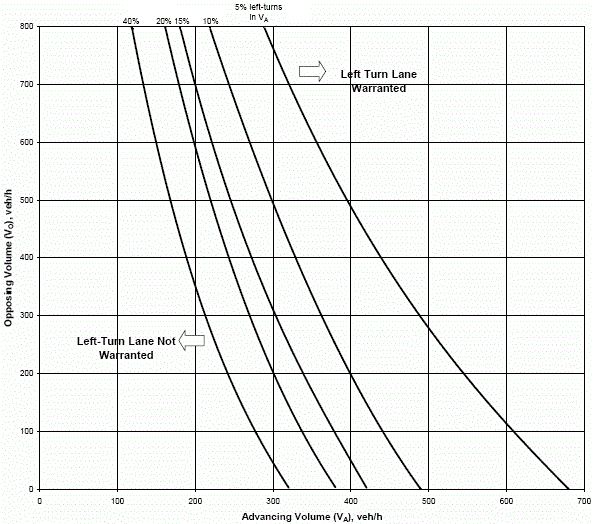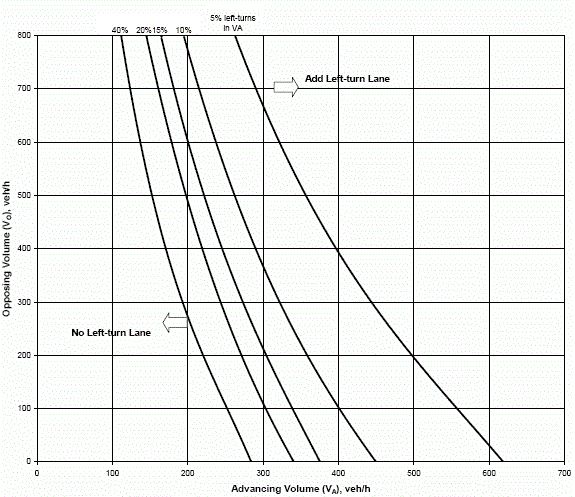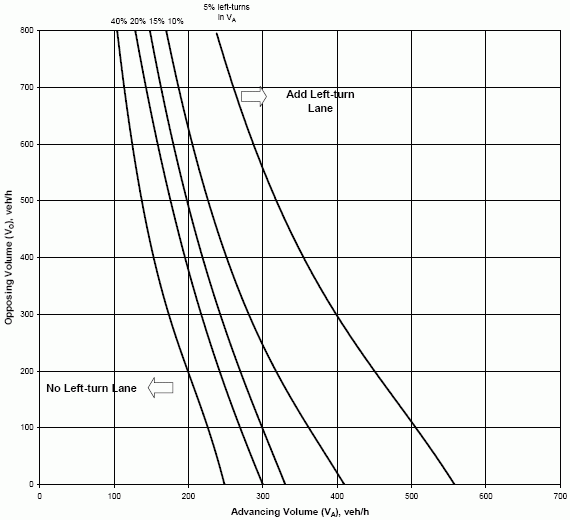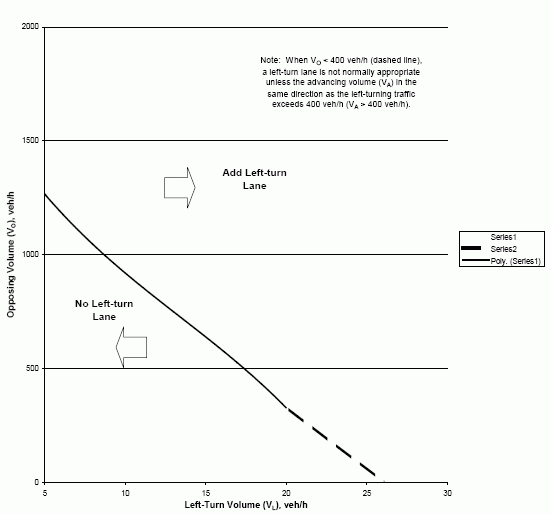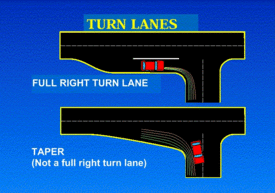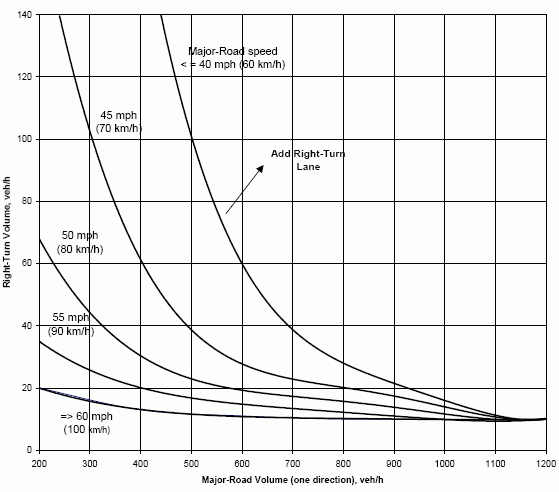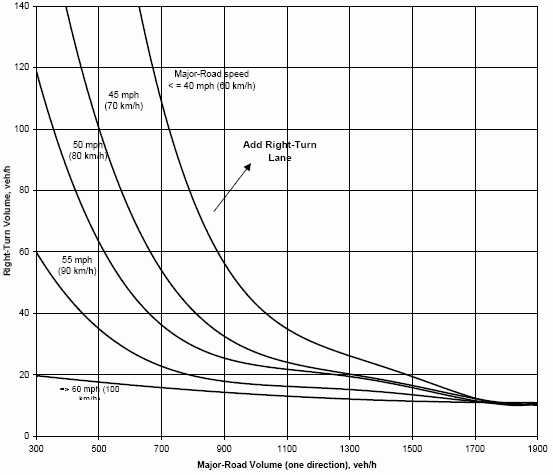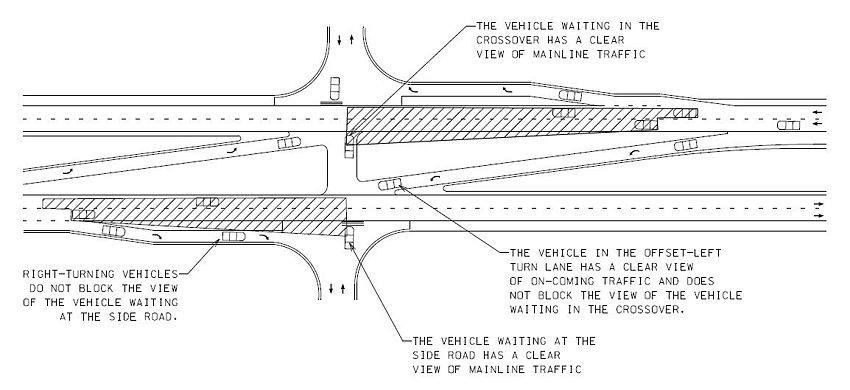940.9 Auxiliary Acceleration and Turning Lanes
Dedicated left- and right-turn lanes are to be provided in situations where traffic volumes and speeds are relatively high and conflicts are likely to develop at public road intersections and driveways between through and turning traffic. Auxiliary lanes are an asset in promoting safety and improved traffic flow in such situations. Some major applications and considerations for the design of auxiliary lanes are as follows:
- Installing a right-turn acceleration lane. These lanes allow entering vehicles (those that have turned right from a driveway or minor public road onto the major route) to accelerate before entering the through-traffic flow. Acceleration lanes are to be considered on roadway segments, intersections and driveways with high traffic volumes where speed differential could result in unacceptable conflicts and/or delay. Acceleration lanes may also be appropriate where crash experience indicates a problem with right turning, entering vehicles. The right-turn acceleration lane is to be sufficiently long to allow safe and efficient merge maneuvers. The design length, tapers and other features of right-turn acceleration lanes are to be guided by a traffic study.
- Installing auxiliary left-turn lanes. Such lanes, installed in the roadway center, are intended to remove turning vehicles from the through traffic flow. This reduces the frequency of rear-end collisions at locations where there is considerable left-turn ingress activity, such as major driveways and minor public road intersections. Left-turn lane warrants are shown in following figures. To use the figures, peak hour traffic counts including directional splits, which may be obtained from district Traffic staff, will be required. In addition, the ITE Trip Generation Manual may be used as an estimate for peak hour traffic counts. Planning can provide necessary growth rates for design year analyses.
- The use and design of auxiliary left-turn lanes are to be guided by a traffic study. In general, auxiliary left-turn lanes must be long enough to accommodate a safe deceleration distance and provide adequate storage for an expected peak hour turning traffic queue. Refer to storage and deceleration lengths for additional information.
Contents
- 1 940.9.1 Left Turn Lane Guidelines for Two-Lane Roads less than or equal to 40 mph
- 2 940.9.2 Left Turn Lane Guidelines for Two-Lane Roads, 45 mph
- 3 940.9.3 Left Turn Lane Guidelines for Two-Lane Roads, 50 mph
- 4 940.9.4 Left Turn Lane Guidelines for Two-Lane Roads, 55 mph
- 5 940.9.5 Left Turn Lane Guidelines for Two-Lane Roads, 60 mph
- 6 940.9.6 Left Turn Lane Guidelines for Four-Lane Roadways
- 7 940.9.7 Right Turn Lanes
- 8 940.9.8 Right Turn Lane Guidelines for Two-Lane Roadways
- 9 940.9.9 Right Turn Lane Guidelines for Four-Lane Roadways
- 10 940.9.10 Offset Right- and Left-Turn Lanes
940.9.1 Left Turn Lane Guidelines for Two-Lane Roads less than or equal to 40 mph
The following data are required:
1. Opposing Volume (veh/hr) - VO - The opposing volume is to include only the right-turn and through movements in the opposite direction of the left turning vehicle.
2. Advancing Volume (veh/hr) - VA - The advancing volume is to include the right-turn, left-turn and through movements in the same direction as the left turning vehicle.
3. Operating Speed (mph) - The greatest of anticipated operating speed, measured 85th percentile speed or posted speed.
4. Percentage of left turns in VA
Left turn lane is not needed for left turn volume less than 10 vph. However, criteria other than volume, such as crash experience, may be used to justify a left turn lane.
The appropriate trend line is identified on the basis of the percentage of left-turns in the advancing volume, rounded up to the nearest percentage trend line. If the advancing and opposing volume combination intersects above or to the right of this trend line, a left-turn lane is appropriate.
940.9.2 Left Turn Lane Guidelines for Two-Lane Roads, 45 mph
The following data are required:
1. Opposing Volume (veh/hr) - VO - The opposing volume is to include only the right-turn and through movements in the opposite direction of the left turning vehicle.
2. Advancing Volume (veh/hr) - VA - The advancing volume is to include the right-turn, left-turn and through movements in the same direction as the left turning vehicle.
3. Operating Speed (mph) - The greatest of anticipated operating speed, measured 85th percentile speed or posted speed.
4. Percentage of left turns in VA
Left turn lane is not needed for left turn volume less than 10 vph. However, criteria other than volume, such as crash experience, may be used to justify a left turn lane.
The appropriate trend line is identified on the basis of the percentage of left-turns in the advancing volume, rounded up to the nearest percentage trend line. If the advancing and opposing volume combination intersects above or to the right of this trend line, a left-turn lane is appropriate.
940.9.3 Left Turn Lane Guidelines for Two-Lane Roads, 50 mph
The following data are required:
1. Opposing Volume (veh/hr) - VO - The opposing volume is to include only the right-turn and through movements in the opposite direction of the left turning vehicle.
2. Advancing Volume (veh/hr) - VA - The advancing volume is to include the right-turn, left-turn and through movements in the same direction as the left turning vehicle.
3. Operating Speed (mph) - The greatest of anticipated operating speed, measured 85th percentile speed or posted speed.
4. Percentage of left turns in VA
Left turn lane is not needed for left turn volume less than 10 vph. However, criteria other than volume, such as crash experience, may be used to justify a left turn lane.
The appropriate trend line is identified on the basis of the percentage of left-turns in the advancing volume, rounded up to the nearest percentage trend line. If the advancing and opposing volume combination intersects above or to the right of this trend line, a left-turn lane is appropriate.
940.9.4 Left Turn Lane Guidelines for Two-Lane Roads, 55 mph
The following data are required:
1. Opposing Volume (veh/hr) - VO - The opposing volume is to include only the right-turn and through movements in the opposite direction of the left turning vehicle.
2. Advancing Volume (veh/hr) - VA - The advancing volume is to include the right-turn, left-turn and through movements in the same direction as the left turning vehicle.
3. Operating Speed (mph) - The greatest of anticipated operating speed, measured 85th percentile speed or posted speed.
4. Percentage of left turns in VA
Left turn lane is not needed for left turn volume less than 10 vph. However, criteria other than volume, such as crash experience, may be used to justify a left turn lane.
The appropriate trend line is identified on the basis of the percentage of left-turns in the advancing volume, rounded up to the nearest percentage trend line. If the advancing and opposing volume combination intersects above or to the right of this trend line, a left-turn lane is appropriate.
940.9.5 Left Turn Lane Guidelines for Two-Lane Roads, 60 mph
The following data are required:
1. Opposing Volume (veh/hr) - VO - The opposing volume is to include only the right-turn and through movements in the opposite direction of the left turning vehicle.
2. Advancing Volume (veh/hr) - VA - The advancing volume is to include the right-turn, left-turn and through movements in the same direction as the left turning vehicle.
3. Operating Speed (mph) - The greatest of anticipated operating speed, measured 85th percentile speed or posted speed.
4. Percentage of left turns in VA
Left turn lane is not needed for left turn volume less than 10 vph. However, criteria other than volume, such as crash experience, may be used to justify a left turn lane.
The appropriate trend line is identified on the basis of the percentage of left-turns in the advancing volume, rounded up to the nearest percentage trend line. If the advancing and opposing volume combination intersects above or to the right of this trend line, a left-turn lane is appropriate.
940.9.6 Left Turn Lane Guidelines for Four-Lane Roadways
The following data are required:
1. Opposing Volume (veh/hr) - VO - The opposing volume is to include only the right-turn and through movements in the opposite direction of the left turning vehicle.
2. Left-Turn Volume – VL
If the opposing and left-turn volume combination intersects above or to the right of the trend line, a left-turn lane is appropriate.
940.9.7 Right Turn Lanes
The use of dedicated right-turn lanes should also be guided by a traffic study. In general, dedicated right-turn lanes should be provided in both rural and urban areas on two lane routes as shown in the figures below. Right-turn lane warrants are shown in the following figures. To use the figures, peak hour traffic counts, including directional splits, will be required, which may be obtained from district Traffic staff. In addition, the ITE Trip Generation Manual may be used as an estimate for peak hour traffic counts. Planning can provide necessary growth rates for design year analyses.
Dedicated right turn lanes are also to be strongly considered in situations where:
- Poor internal site design and circulation leads to backups on the mainline. Auto-oriented businesses with short drive-through lanes or poorly designed parking lots would be prime examples of this situation.
- The peak hour turning traffic activity is unusually high (e.g. greater than 10 percent of the daily total).
- Operating speeds on the mainline route are very high (greater than 60 miles per hour) and drivers would generally not expect right turns.
- The driveway or minor public road intersection is difficult for drivers to see.
- The driveway entrance is gated or otherwise must be entered very slowly.
- Right turning traffic consists of an unusually high number of trailers or other large vehicles.
- The intersection or driveway angle is highly skewed.
- Rear end collision experience is unusually high at a location.
As with any auxiliary turning lane, dedicated right-turn lanes are to be designed based on the results of a traffic study.
940.9.8 Right Turn Lane Guidelines for Two-Lane Roadways
The following data are required:
1. Advancing Volume (veh/hr) - The advancing volume is to include the right-turn, left-turn and through movements in the same direction as the right turning vehicle.
2. Right Turning Volume (veh/hr) - The right turning volume is the number of advancing vehicles turning right.
3. Operating Speed (mph) - The greatest of anticipated operating speed, measured 85th percentile speed or posted speed.
Note: Right turn lane is not needed for right turn volume less than 10 vph. However, criteria other than volume, e.g. crash experience, may be used to justify a right turn lane.
If the combination of major road approach volume and right-turn volume intersects above or to the right of the speed trend line corresponding the major road operating speed, then a right-turn lane is appropriate.
940.9.9 Right Turn Lane Guidelines for Four-Lane Roadways
The following data are required:
1. Advancing Volume (veh/hr) - The advancing volume is to include the right-turn, left-turn and through movements in the same direction as the right turning vehicle.
2. Right Turning Volume (veh/hr) - The right turning volume is the number of advancing vehicles turning right.
3. Operating Speed (mph) - The greatest of anticipated operating speed, measured 85th percentile speed or posted speed.
Note: Right turn lane not warranted for right turn volume less than 10 vph. However, criteria other than volume, e.g. crash experience, may be used to justify a right turn lane.
If the combination of major road approach volume and right-turn volume intersects above or to the right of the speed trend line corresponding the major road operating speed, then a right-turn lane is appropriate.
940.9.10 Offset Right- and Left-Turn Lanes
Vehicles in the right-turn lane tend to obstruct the vision of drivers waiting at the stop bar of the minor roadway. One way to reduce the obstruction of the minor roadway drivers’ view is to offset the right-hand turning bay to the right. Similarly, vehicles in the opposing left-turn lane block the views of left-turning vehicles from the opposite direction. Offsetting left-turn lanes to the left as far as practical improves the visibility of opposing traffic. By improving the visibility of opposing traffic, drivers can more effectively use available gaps. Offsetting right-turn lanes to the right gives drivers on the minor approach (at the stop bar) an unobstructed view of oncoming traffic in the near expressway lanes, which allows for more effective use of gaps.
Consideration is to be given to offset right- and left-turn lanes lane in locations with high mainline operating speeds, large percentage of turning trucks, unique sight distance issues or crash experience where investigation of crash diagrams indicates a safety benefit may be obtained from an offset turn lane. When implementing offset auxiliary turn lanes, ensure the horizontal geometry of the roadway does not negate the line-of-sight improvement.

